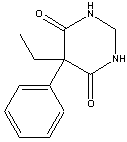Mysoline
Primidone, is an anticonvulsant of the pyrimidinedione class whose active metabolites, phenobarbital (minor) and phenylethylmalonamide (PEMA) (major), are also anticonvulsants. Like many anticonvulsants, it is a GABA receptor agonist (i.e., it simulates the action of GABA in the central nervous system). more...
It has been available as a generic drug from Lannett since 1978.
Metabolism
Primidone converts to phenobarbital and PEMA via the CYP2C19 and CYP2C9 hepatic enzymes. The phenobarbital, in turn, is metabolized to p-hydroxyphenobarbital. Alvin, Goh, and Bush reported in 1975 that the rate of primidone metabolism was greatly accelerated by phenobarbital pretreatment, moderately accelerated by primidone pretreatment, and reduced by PEMA pretreatment. In 1983, a new minor metabolite, p-hydroxyprimidone, was discovered.
Uses
Primidone is used to treat, but not cure, the following conditions in the following countries:
Approved Uses
United Kingdom
According to the National Collaborating Center for Primary Care, primidone is licensed for generalized tonic-clonic seizures and complex partial seizures.
United States
In the United States, primidone is approved for adjunctive (in combination with other drugs) monotherapy (by itself)) in generalized tonic-clonic seizures, nocturnal myoclonic seizures, simple partial seizures, and complex partial seizures.
Unapproved/Investigational/Off-Label Uses
Primidone is considered to be a first-line therapy for essential tremor along with propranolol and was first used for it in 1981. Serrano-Duenas found in 2003 that 250 mg/day was at least as effective for this as 750 mg/day and with fewer side effects.
There are three case reports, one from 1980, one from 1986, and another from 2002, where primidone was specifically mentioned as being used in the treatment of congenital long QT syndrome. The first case involves three patients, the first a 31-year-old white woman who still had ventricular fibrillation, syncope, and seizures even after left stellate ganglionectomy and thoracic chain dissection; the primidone suppressed the fibrillations and lengthened the QT interval for two years and eight months in the patient. She had previously been tried on phenobarbital-phenytoin (when she was thought to have only seizures), phenobarbital-phenytoin-procainamide, phenobarbital-phenytoin-propanolol, phenobarbital-phenytoin-procainamide (when propanolol brought the tachycardia back almost instantaneously upon the first dose), phenobarbital-phenytoin-atropine-acetylstrophanthidin, and phenobarbital-phenytoin-lidocaine prior to the surgery. After the surgery, the QT-prolongation returned, so the phenytoin was doubled to 200 mg qid. A month later, she was admitted to the hospital for phenytoin toxicity, where it was found that she had slow spike and abortive wave activity in her left temporal lobe. It was after this that primidone was substituted for phenytoin. The other two patients are the first one's 16-year-old niece and 15-year-old nephew, both brother and sister. The niece was started on primidone after an unsuccessful trial of phenytoin and the nephew was started because of family history.
Read more at Wikipedia.org



